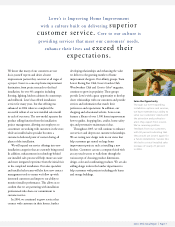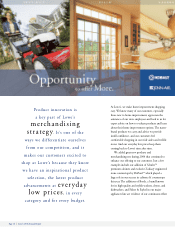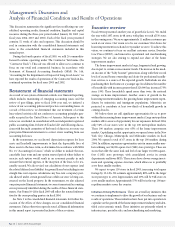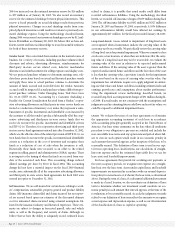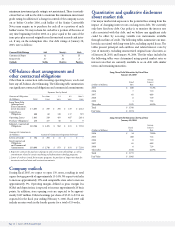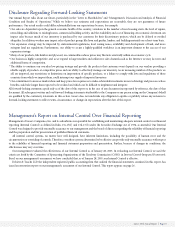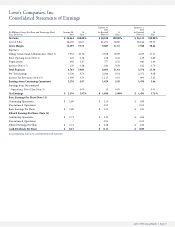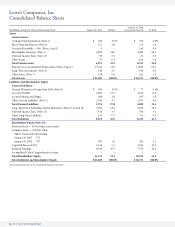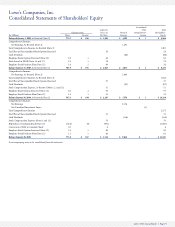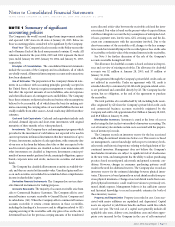Lowe's 2004 Annual Report Download - page 25
Download and view the complete annual report
Please find page 25 of the 2004 Lowe's annual report below. You can navigate through the pages in the report by either clicking on the pages listed below, or by using the keyword search tool below to find specific information within the annual report.
Lowe’s 2004 Annual Report Page 23
Percentage Increase/
(Decrease) in
Dollar Amounts
from Prior Year
2003- 2002-
(In Millions) 2004 2003 2002 2004 2003
Net Cash Provided by
Operating Activities from
Continuing Operations $ 3,033 $ 2,942 $ 2,654 3% 11%
Net Cash Used in
Investing Activities from
Continuing Operations (2,257) (2,497) (2,477) (10) 1
Net Cash Used in
Financing Activities from
Continuing Operations (1,047) (17) (64) NM (73)
Net Cash Provided by
Discontinued Operations – 112 16 NM NM
Net (Decrease) Increase in
Cash and Cash Equivalents (271) 540 129 (150) 319
Cash and Cash Equivalents,
Beginning of Year 913 373 244 145 53
Cash and Cash Equivalents,
End of Year $ 642 $ 913 $ 373 (30%) 145%
* NM: Not Meaningful
Cash flows from operating activities provide a significant source of
our liquidity. The increase in cash provided by operating activities
during 2004 resulted primarily from increased net earnings, offset by
our investment in inventory in the current year as a part of the R3 ini-
tiative. The increase in cash provided by operating activities during
2003 resulted primarily from increased net earnings. Working capital
at January 28, 2005, was $1.3 billion compared to $2.3 billion at
January 30, 2004. The decrease in working capital was due primarily to
share repurchases during fiscal 2004 and our aforementioned invest-
ment in inventory.
The primary component of net cash used in investing activities
from continuing operations continues to be new store facilities and the
infrastructure and technology needed to support this growth. Cash
acquisitions of fixed assets were $2.9 billion for 2004 and $2.3 billion
in both 2003 and 2002. Retail selling space of 123.7 million square feet
as of January 28, 2005, increased 14% over the selling space as of
January 30, 2004. The January 30, 2004, selling space total of 108.8 mil-
lion square feet represented a 15% increase over January 31, 2003.
Cash flows used in financing activities from continuing operations
increased significantly in 2004 due to our $1 billion share repurchase
program. Financing uses of cash in 2003 and 2002 primarily consisted
of cash dividend payments, repayment of short-term borrowings and
scheduled debt repayments. These uses were partially offset by pro-
ceeds generated from stock option exercises and cash proceeds from
the employee stock purchase plan. The ratio of long-term debt to equi-
ty plus long-term debt was 21.0%, 26.5% and 31.2% as of the fiscal
years ended 2004, 2003 and 2002, respectively.
Sources of Liquidity In addition to our cash flows from operations, we
have a $1 billion senior credit facility that expires in July 2009. The facil-
ity is available to support the Company’s $1 billion commercial paper
program and for short-term borrowings. Borrowings made are priced
based upon market conditions at the time of funding in accordance
with the terms of the senior credit facility. The senior credit facility con-
tains certain restrictive covenants which include maintenance of a spe-
cific financial ratio. We were in compliance with those covenants at
January 28, 2005. Fifteen banking institutions are participating in the
$1 billion senior credit facility and, as of January 28, 2005, there were
no outstanding loans under the facility.
Five banks have extended lines of credit aggregating $513 million
for the purpose of issuing documentary letters of credit and standby
letters of credit. These lines do not have termination dates but are
reviewed periodically. Commitment fees ranging from .25% to .50%
per annum are paid on the letters of credit amounts outstanding.
Outstanding letters of credit totaled $304 million as of January 28,
2005, and $161 million as of January 30, 2004.
Cash Requirements In January 2005, the Board of Directors author-
ized up to $1 billion in share repurchases through 2006. This program
is intended to be implemented through purchases made from time to
time either in the open market or through private transactions. Shares
purchased under the share repurchase program are retired and
returned to authorized and unissued status. As of January 28, 2005, the
share repurchase program had a remaining authorized balance of
$1 billion for future common stock repurchases. During fiscal 2004,
we repurchased 18.4 million shares at a total cost of $1 billion under
the December 2003 share repurchase authorization, leaving no
amounts remaining under this prior authorization.
Our quarterly cash dividend per share was increased in 2003 to
$0.03 and again in 2004 to $0.04. This increased cash paid for divi-
dends in 2004 as compared to 2003.
During fiscal year 2005, long-term debt totaling $608 million will
mature. We anticipate having the ability to repay this debt through
cash from operations.
Our 2005 capital budget is $3.7 billion, inclusive of approximately
$335 million of leases. Approximately 78% of this planned commit-
ment is for store expansion and new distribution centers. Expansion
plans for 2005 consist of approximately 150 stores, including approxi-
mately three relocations of older stores. This planned expansion is
expected to increase sales floor square footage by approximately 13-
14%. Approximately 68% of the 2005 projects will be owned, 31% will
be ground leased properties and 1% will be built-to-suit leases.
At January 28, 2005, we owned and operated 10 regional distribu-
tion centers. We began shipping from another regional distribution
center in Plainfield, Connecticut, in February 2005. At the end of fis-
cal 2004, we owned and operated 10 flatbed distribution centers for
the handling of lumber, building materials and other long-length
items. We expect to open three additional flatbed distribution centers
in 2005.
We believe that funds from operations and funds available from
our credit facilities will be adequate to finance our expansion plans
and other operating requirements. However, general economic down-
turns, fluctuations in the prices of products and unanticipated impact
arising from competition could have an effect on funds generated
from operations and our future expansion plans. In addition, the
availability offunds through the issuance of commercial paper and
new debt could be adversely affected due to a debt rating downgrade
or a deterioration of certain financial ratios. There are no provisions in
any agreements that would require early cash settlement of existing
debt or leases as a result of a downgrade in our debt rating or a
decrease in our stock price. Holders of the $580.7 million Senior
Convertible notes may convert their notes into common stock if the


